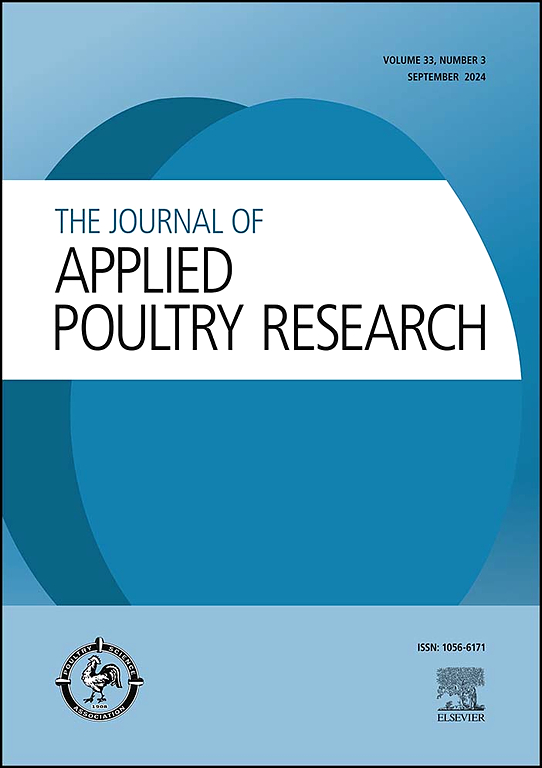桉树叶粉对 Isa 棕色小母鸡生长性能、内脏重量、血液学和生化指标的影响
IF 2
3区 农林科学
Q2 AGRICULTURE, DAIRY & ANIMAL SCIENCE
引用次数: 0
摘要
鸡体内的有害细菌阻碍了家禽生产,而所使用的抗生素生长促进剂(AGP)则带来了与家禽产品中残留物有关的公共卫生问题。2006 年,世界卫生组织禁止使用 AGP。因此,本研究旨在评估球桉叶粉(EgLP)作为生长促进剂对 Isa 棕色小母鸡的影响。从第9周到第20周,对生长参数、内脏器官、血液学和生化参数进行了评估。将440只56日龄的伊莎褐小鸡随机分配到5组,每组4个重复,每个重复22只小鸡。处理包括不含 EgLP 和抗生素的对照日粮(CD)、阴性对照(B- 组)、含抗生素但不含 EgLP 的 CD、阳性对照(B+ 组)、CD + 0.25% EgLP 且不含抗生素(B1 组)、CD + 0.50% EgLP 且不含抗生素(B2 组)以及 BD + 1% EgLP 且不含抗生素(B3 组)。研究结果表明,与使用抗生素的批次一样,使用 0.5% EgLP 的小母鸡在生长期结束时的体重、采食量和增重最高。生化指标,如丙氨酸氨基转移酶和天门冬氨酸氨基转移酶的浓度,没有受到添加EgLP的影响。在血液学参数方面,只有阴性对照组小母鸡的白细胞数量在统计学上较高。总之,本研究结果表明,0.5%的EgLP可有效替代生长期伊萨褐小鸡的抗生素。本文章由计算机程序翻译,如有差异,请以英文原文为准。
Effects of Eucalyptus globulus leaves powder on growth performance, internal organs weights, hematological and biochemical parameters of Isa brown pullets
The harmful chickens bacteria impedes poultry production and the antibiotics growth promoters (AGP) used presents a public health problem related to residues in poultry products. In 2006, the world health organization prohibited the use of AGP. Indeed, this study was conducted to evaluate the influence of Eucalyptus globulus leaf powder (EgLP) as a growth promoter in Isa brown pullets. The growth parameters, Internal organs, hematology, and biochemical parameters were evaluated from the 9th to the 20th week. A total of 440 56-day-old Isa brown pullets were randomly allocated to 5 groups, each consisting of 4 replications, with 22 pullets in each replication. Treatments consisted of the control diet (CD) without EgLP and antibiotics, a negative control (group B-), CD with antibiotics and no EgLP, a positive control (group B+), CD + 0.25% of EgLP without antibiotic (group B1), CD with 0.50% of EgLP without antibiotic (group B2), and BD with 1% EgLP without antibiotic (group B3). The study reveled that pullet on 0.5% EgLP had the highest weight, feed intake and body weight gain at the end of the grower phase, as like the batches treated with antibiotics. The biochemical parameters such as Alanine aminotransferase and Aspartate aminotransferase concentration were not affected by EgLP supplementation. For hematological parameters, only the leukocytes number from the negative control pullets was statistically higher. In conclusion, the results of this study showed that 0.5% of EgLP served as a useful replacement for antibiotic in Isa brown pullets in the grower phase.
求助全文
通过发布文献求助,成功后即可免费获取论文全文。
去求助
来源期刊

Journal of Applied Poultry Research
农林科学-奶制品与动物科学
CiteScore
4.10
自引率
10.50%
发文量
80
审稿时长
104 days
期刊介绍:
The Journal of Applied Poultry Research (JAPR) publishes original research reports, field reports, and reviews on breeding, hatching, health and disease, layer management, meat bird processing and products, meat bird management, microbiology, food safety, nutrition, environment, sanitation, welfare, and economics. As of January 2020, JAPR will become an Open Access journal with no subscription charges, meaning authors who publish here can make their research immediately, permanently, and freely accessible worldwide while retaining copyright to their work. Papers submitted for publication after October 1, 2019 will be published as Open Access papers.
The readers of JAPR are in education, extension, industry, and government, including research, teaching, administration, veterinary medicine, management, production, quality assurance, product development, and technical services. Nutritionists, breeder flock supervisors, production managers, microbiologists, laboratory personnel, food safety and sanitation managers, poultry processing managers, feed manufacturers, and egg producers use JAPR to keep up with current applied poultry research.
 求助内容:
求助内容: 应助结果提醒方式:
应助结果提醒方式:


